3D printing filaments for engineers – a practical guide
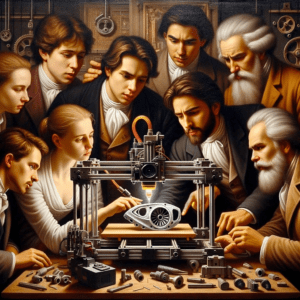
3D printing, over the last decade, has transformed from a niche prototyping technology into a powerful manufacturing tool that is now an integral part of many fields of engineering and manufacturing. This dynamically developing production method enables the quick and effective creation of objects with complex geometries that were previously difficult or even impossible to produce using traditional methods.
The choice of 3D printing filament is a key aspect of the process, having a direct impact on the mechanical, thermal and chemical properties of the finished product. A properly selected filament can significantly increase the functionality and durability of objects, opening up new opportunities and horizons for engineers and designers in the field of production and prototyping. Properties such as strength, flexibility, resistance to temperature and chemicals are crucial when choosing the right filament, adapted to the specific nature of the project and the conditions in which the finished element will be used.
Here are some suggestions for 3D printing filaments that should be in every engineer’s studio.
Nylon with carbon fibers (CF)
Nylon+CF – nylon reinforced with carbon fiber, is one of the most advanced materials used in 3D printing in the field of engineering. This material combines the strength and lightness of nylon with high stiffness and thermal resistance provided by the addition of carbon fibers. The result is a filament that offers excellent mechanical properties, enabling the creation of components with high strength and stiffness at low weight. CF nylon is also resistant to many chemicals, making it an ideal choice for the chemical and automotive industries.
Tips for 3D printing Nylon with carbon: Printing Nylon with CF requires the use of a heated bed to prevent deformation caused by rapid cooling. For best results, the printing temperature should be between 255 and 270°C and for the platform suggested temperature is 90 to 110°C. It is also recommended to use an adhesive (e.g. Magigoo PA) on the table to improve the adhesion of the first layer. CF nylon is also hygroscopic, which means it absorbs moisture from the environment. Store the filament in a dry place and ensure proper drying before use. Drying of Nylon with CF can be carried out at 80°C for 4 hours.
Advantages of Nylon with CF:
- High mechanical strength
- Excellent thermal resistance (up to 160°C)
- Wear resistance
Disadvantages of Nylon with CF:
- Difficulties with adhesion to the bed
- High price
- Requires the use of a nozzle with increased resistance
- High hygroscopicity
Applications: Optimal for mechanical parts, tools and components in industrial environments.

3D printed tool – Nylon PA12+CF15
ABS (Acrylonitrile Butadiene Styrene)
ABS is one of the most popular filaments, often used in prototyping and producing objects with complex geometry. It is a thermoplastic polymer that offers good strength and flexibility, as well as the ability to be easily processed after printing, such as sanding or painting. ABS is also resistant to various solvents, which increases its versatility of use. However, it is susceptible to acetone, which can be used to smooth the model or glue elements together. ABS has a tendency to warp during printing due to uneven cooling, which may require the use of a heated printing chamber. It also emits a strong odor during printing, so proper ventilation of the room and the use of carbon filters in the 3D printer are required.
Tips for 3D printing ABS: The ABS filament typically requires an extruder temperature between 250-265°C and a heated print bed with the temperature set to around 90-110°C to prevent the model from warping. Using a closed print chamber helps maintain a constant temperature during printing. Using glue, tape or other adhesive agents can help prevent problems with the adhesion of the first layer to the substrate.
Advantages of ABS:
- Easy to mechanical and chemical processing
- Good strength and flexibility
- Low price
Disadvantages of ABS:
- Emission of irritating fumes during printing
- Tending to warp
Applications: Perfect for printing utility prototypes, electronics housings and automotive components.
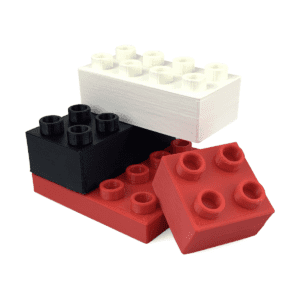
3D printed elements – ABS
ASA (Acrylonitrile Styrene Acrylate)
The ASA filament is a material similar to ABS, but it is more resistant to UV rays and weather conditions. Thanks to these properties, ASA 3D printing filament is an ideal choice for the production of elements that will be exposed to external conditions, such as parts of cars or machines intended for outdoor use, or e.g. building finishing elements. ASA also retains good mechanical properties and, just like ABS, is easy to process. The high printing temperature and the need for good ventilation (due to the fumes released) are the main challenges when using this material.
Tips for 3D printing ASA: Printing with ASA filament requires an extruder temperature of approximately 255-270°C and a heated bed with a temperature of 90-110°C. It is also recommended to use a closed printing chamber and ventilation due to the fumes emitted. Good adhesion of the first layer can be achieved by using adhesive sprays or liquids on the printing surface.
Advantages of ASA:
- Resistance to UV and weather conditions\
- Good mechanical strength
Disadvantages of ASA:
- Higher price than ABS
- Needs a well-ventilated space
Applications: Perfect for outdoor applications such as car or machine parts, construction elements and decorations.
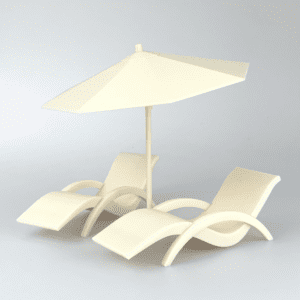
3D printed models – ASA
TPU/TPE (Thermoplastic Polyurethane/Elastomer)
TPU and TPE are 3D printing filaments that are characterized by high flexibility, tensile strength and crushing resistance. They are ideal for creating flexible and durable elements such as seals, covers, adapters and footwear and clothing elements. The flexibility of these materials makes them more demanding when printing and may require special extruders and careful selection of printing parameters. They are resistant to abrasion, but may also be sensitive to some chemicals and solvents. The hardness of flexible filaments is determined on the Shore scale, usually type A or D. The lower the value, the softer the filament. The most common values for TPU/TPE 3D printing filaments are 30-40D and 90-98A.
Tips for 3D printing TPU/TPE: The recommended printing temperature for TPU/TPE is 200-240°C, and the printing speed should be lower than that of typical filaments. The table should be set at room temperature or slightly higher, up to about 60°C. Due to the flexibility of the material, it is recommended to use a direct extruder to prevent problems with filament feeding.
Advantages of TPU/TPE:
- Flexibility
- Abrasion resistance
- Resistance to UV
Disadvantages of TPU/TPE:
- Difficulty printing
- Sometimes it requires special extruders
- With long exposure to weather conditions, it may lose elasticity
Applications: Flexible elements, such as seals, covers, adapters, footwear and clothing elements, impact-absorbing elements, handles.
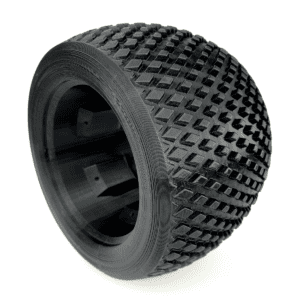
3D printed tire – Fiberlogy FiberFlex 40D
PET-G (Polyethylene Terephthalate Glycol)
PET-G filament is an excellent material for those who are looking for a balance between durability and ease of printing. Modification of commonly used PET with glycol makes it more resistant to cracks. PET-G is also resistant to many chemicals and has good layer adhesion, which is crucial for the durability of printed elements. The availability of PET-G in a transparent version means that it is often used to produce lighting elements, e.g. housings or lamp shades. Even though the PET-G filament is considered one of the easier materials for 3D printing, it may cause some difficulties due to the tendency to dirty or stick the nozzle, as well as due to frequent stringing, which may result from the moisture of the filament .
Tips for 3D printing PET-G: The recommended printing temperatures range for PET-G is from 220 to 250°C, with the printing platform heated to approximately 90°C. PET-G has very good adhesion, which can sometimes even lead to damage to the table surface, especially if it is made of glass. Therefore, it is advised to prepare the table by using, e.g. hairspray. It will ensure good adhesion of the model and protect it against damage. Pay attention to setting good retraction to avoid problems with riveting, as well as properly drying the filament before printing (4 hours at 60°C).
Advantages of PET-G:
- High durability
- Clarity
- Chemical resistance
- High stiffness
Disadvantages of PET-G:
- It may dirty the nozzle
- Requires accurate calibration of the 3D printer
- Susceptibility to scratches
- High hygroscopicity
Applications: It is perfect for the production of lamp covers or housings, e.g. for batteries and accumulators.
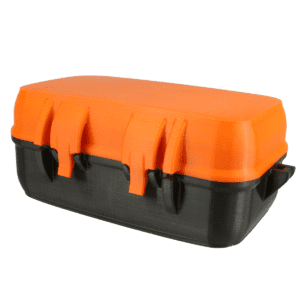
3D printed model – PET-G
PP (Polypropylene)
Polypropylene is a very light (only approx. 1 g/cm3), chemical-resistant and highly flexible material that is used in many fields of engineering. PP filament is the perfect choice for printing hinges, clips or other components that need to withstand repeated movements or pressure. Its main challenge is difficulty with adhesion to the printing surface and poor adhesion between layers, which may affect the strength of the final object. PP is also a fatigue-sensitive material and may be susceptible to degradation under long-term pressure or loads.
Tips for 3D printing PP: PP printing is best carried out at an extrusion temperature between 220 and 250°C, with the bed heated up to approximately 100°C. To improve adhesion, you can use packaging tape, which itself is made of PP, thanks to which it holds PP perfectly. Because PP is flexible and tends to warp, it is recommended to print at a slower speed and use a brim or raft to improve adhesion and print stability.
Advantages of PP:
- Low weight
- Resistant to most chemicals
- Flexibility
Disadvantages of PP:
- Difficult to print due to poor layer adhesion
- It may lose elasticity over time
- Vulnerability to shrinkage
Applications: Suitable for containers, hinges and elements that come into contact with chemicals.

3D prints made of Polypropylene (PP)
Each 3D printing filament has its own unique properties that work best in specific applications. When choosing a material, it is important to take into account the specificity of the project and the conditions in which the element will be used.
By discovering different materials, their advantages, disadvantages and specifics of 3D printing, we gain a solid foundation that will help us choose the most appropriate filament to implement specific projects and ideas. Each material brings unique opportunities, but also challenges that require rethinking and adapting the printing process. Taking into account the presented information, we can make informed decisions, adapting the 3D printing technology to the requirements and expectations of our engineering projects, which will allow us to achieve optimal and satisfactory results.